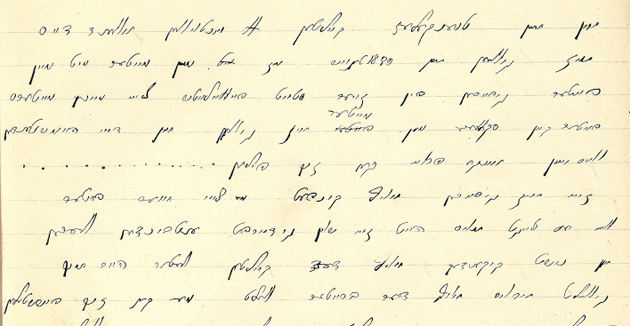מײַן באַליבטסטע ירושה־זאַך: מײַן באָבעס טאָגביכער
Favorite Heirloom: My Grandmother's Diary
פֿון מיטשעל עלינסאָן
SCROLL DOWN FOR ENGLISH
מיט עטלעכע חדשים צוריק האָבן מיר געבעטן אונדזערע לייענער — סײַ פֿונעם ייִדישן פֿאָרווערטס, סײַ פֿונעם ענגלישן — איר זאָלט אונדז צושיקן אַ פֿאָטאָגראַפֿיע און באַשרײַבונג פֿון אײַער באַליבטסטער ירושה־זאַך. דער אָפּרוף איז געווען אַן ענטוזיאַסטישער. אָנהייבנדיק די ערשטע וואָך אין מײַ, דעם חודש געווידמעט דער ייִדישער אַמעריקאַנער קולטור־ירושה, שטעלן מיר יעדן טאָג אַרויף איינע פֿון די ירושה־מעשׂיות.
דורך די אַלע חפֿצים וועט איר זיך אַ ביסל דערוויסן וועגן די אינטערעסאַנטע משפּחה־געשיכטעס פֿון אונדזערע לייענער, און במילא זיך באַקענען מיט געוויסע אַספּעקטן פֿון דער ייִדישער קולטור־געשיכטע פֿון אַ מער פּערזענלעכן קוקווינקל.
מײַן באָבעס טאָגביכער
פֿון מיטשעל עלינסאָן
בײַם אַריבערפֿירן אונדזערע עלטערן אין אַ הויז פֿאַר עלטערע לײַט האָבן מיר אַנטדעקט עטלעכע העפֿטן אָנגעשריבן אויף ייִדיש. כאָטש ביידע עלטערן זענען דערצויגן געוואָרן בײַ ייִדיש־רעדנדיקע משפּחות, האָבן זיי ניט געקענט דעשיפֿרירן וואָס עס שטייט דאָרט געשריבן אַחוץ עטלעכע דאַטעס.
מיר זענען געווען שטאַרק נײַגעריק צו וויסן וואָסערע געשיכטעס ליגן דאָרטן באַהאַלטן און האָבן געוואָלט געפֿינען אַ מענטשן וואָס זאָל זיי איבערזעצן. כאָטש די מאַמע האָט די אַלע יאָרן געהאַלטן די ביכער, האָט זי נישט געוואָלט וויסן וואָס איר מאַמע האָט דאָרט געשריבן.
נאָך דעם וואָס אונדזער מאַמע איז ניפֿטר געוואָרן האָבן מיר געפֿונען עטלעכע איבערזעצער. אין די טאָגביכער באַשרײַבט די באָבע איר לעבן, אָנהייבנדיק פֿון איר געבוירן ווערן אין 1889 ביזן געבוירן ווערן פֿון אירע קינדער אין 1916. זי שרײַבט וועגן איר אַרבעט אין אַ סוועטשאַפּ, איר לײַדן פֿון טובערקולאָז, איר פּאָליטישן אַקטיוויזם, אַ טרויעריקער ליבע און אירע באַמיִונגען זיך אויסצוהיילן פֿון איר דעפּרעסיע דורך אַ נסיעה צוריק צו איר שטעטל ווען זי איז געווען 20 יאָר אַלט.
אַלע ספֿקות וואָס מיר האָבן געהאַט וועגן דעם, צי מיר זאָלן אַנטפּלעקן דער באָבעס סודות זענען נעלם געוואָרן ווען מיר האָבן באַקומען די ערשטע זײַט פֿון דער איבערזעצונג, מיט די שורות:
„איך בין נאָך זייער יונג אָבער איך האָב שוין דורכגעלעבט אַ ים מיט צרות און איך וויל, אַז מײַנע פֿרײַנד, ווי אויך מײַנע קינדער, זאָלן וויסן, וואָס איך האָב דורכגעמאַכט און באַקומען חיזוק דערפֿון. איך וויל אַלצדינג פֿאַרשרײַבן, אָנהייבנדיק מיט מײַן געבוירן ווערן ביז איך פֿאַרמאַך די אויגן צום לעצטן מאָל. עס וועט זײַן אַ שיין פּעקל צרות וואָס איך גיב איבער.‟
Several months ago we asked you, readers of the Yiddish and English Forward, to send us a photo and description of your favorite heirloom. The response was an enthusiastic one. Beginning the first week of May, Jewish American Heritage Month, we will publish each of these stories daily on our website.
By reading about these family treasures, you will discover some of the fascinating family histories of our readers, as well as their Jewish cultural context from a personal perspective.
If you can read some Yiddish, try reading the Yiddish passage above, which comes with a special feature: every time you click on a word, the English translation appears!
My Grandmother’s Journal
by Mitchell Elinson
In the course of moving our parents from their house to a senior residence, we came across several composition books filled with writing in Yiddish. Despite having grown up in Yiddish-speaking homes, neither of them could decipher much more than some dates.
We were very curious as to what stories lay hidden in the books and wanted to find someone to translate them. Interestingly, although our mother had kept the books, she didn’t want to know what her mother had written. After our mother passed away, we found a couple of translators. The journals describe our grandmother’s life from her birth in 1889 in Russia to the birth of her children in 1916. They include accounts of her work in a sweatshop, her battle with tuberculosis, her political activism, a sad love affair and an attempt to overcome her depression by traveling back to her shtetl when she was twenty.
Any lingering doubts we had about opening our grandmother’s long-kept secrets disappeared when we received the first page of translation which had these lines:
I am still very young but I have already lived through quite a bit of troubles and hope my friends, as well as the children that I will have some day, will know what I have endured and I hope that they will get something out of it. I want to write it all down, starting with my birth until I close my eyes for the last time. It will be quite a pack of troubles that I will go through.






